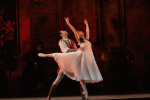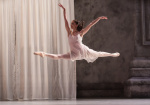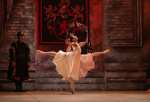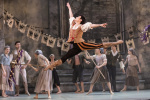Welcome to London Grip, a forum for reviews of books, shows & events – plus quarterly postings of new poetry. Our most recent posts are listed below. Older posts can be explored via the search box and topic list. For more information & guidelines on submitting reviews or poems please visit our Home page.
Sadler’s Wells
Northern Ballet Theatre
Julia Pascal
This production has not been seen in London since 2009. Consequently, most Londoners will know revivals of Kenneth MacMillan’s famous 1965 version which has regularly been performed by the Royal Ballet at Covent Garden. A media frenzy greeted the premiere as Rudolf Nureyev’s defection from the Soviet Union offered him the star role of Romeo alongside Margot Fonteyn as Juliet.
It is hard not to compare Macmillan’s creation to this 1991 adaptation by Christopher Gable, choreographed by Massimo Moricone. Macmillan conceived the ballet for Christopher Gable and Lyn Seymour and the work was made for and on their bodies. When Seymour was replaced with Fonteyn and Gable with Nureyev, there was a feeling that they were cheated. However Gable (and Seymour) did triumph in the second castings and Gable’s ongoing conversation with the ballet gives this adaptation has great depth.
What is most interesting is the change in dramaturgy. Whereas MacmIllan’s Juliet is a girl with a doll, the Gable and Moricone creation characterise her as a girl ready for marriage. This Juliet is already sexually aware whereas MacMillan’s Juliet’s sudden awakening happens with Romeo. This is an interesting reading.
Northern Ballet Theatre’s dramaturgy also shifts the patriarchal cruelty from Juliet’s father to her potential husband. When Paris takes the strap to her the effect is shocking.
There are moments of foreshadowing added to the narrative. At the top of the ballet there is a kitschy image as Romeo and Juliet stand on each side of the stage. high on the mausoleum, as strobe shatters their image. This is a trick common to the West End 1970s and 1980s musical. Happily, this signalling was over fast. More successful foreshadowing occurs with the character of Mercutio. In this version he is a trickster who fakes his own death. When it happens for real the effect is doubly poignant. Other notable additions are viscera : a mother howls when her child is killed; voices occasionally punctuates action, Mercutio’s blood is for real.
It is in the third act that that the ballet feels flat. There is little dance and a lot of gesturing. Action is placed so far downstage as to make the stage feel cluttered. MacMillan’s final act revealed the tragedy in a more physically imaginative language.
Lez Brotherston’s flashy lighting also helps to muzzy the stage. A general wash is often the overall lighting design. Certainly, this can look effective with the use of coloured gels but it tends to wipe out individual performance.
But these are quibbles in a fine work which arrives with its stunning ensemble of dancers and the threatened Northern Ballet Sinfonia. The Arts Council is to cut live music for this excellent company. To cut live music in ballet theatre is criminal. Taped taped music will not do. From my stalls seat, I had an image of musicians playing as dancers moved above them in an arresting split-scene shot. This emphasised the thrilling synthesis between dance
and live music. This orchestra fully honoured the magnificent Prokofiev score with energy, passion and possession. Shame on the Arts Council for cutting live music. It is throwing the Crown Jewels into the sea.
Romeo and Juliet
Sadler’s Wells
Northern Ballet Theatre
Julia Pascal
This production has not been seen in London since 2009. Consequently, most Londoners will know revivals of Kenneth MacMillan’s famous 1965 version which has regularly been performed by the Royal Ballet at Covent Garden. A media frenzy greeted the premiere as Rudolf Nureyev’s defection from the Soviet Union offered him the star role of Romeo alongside Margot Fonteyn as Juliet.
It is hard not to compare Macmillan’s creation to this 1991 adaptation by Christopher Gable, choreographed by Massimo Moricone. Macmillan conceived the ballet for Christopher Gable and Lyn Seymour and the work was made for and on their bodies. When Seymour was replaced with Fonteyn and Gable with Nureyev, there was a feeling that they were cheated. However Gable (and Seymour) did triumph in the second castings and Gable’s ongoing conversation with the ballet gives this adaptation has great depth.
What is most interesting is the change in dramaturgy. Whereas MacmIllan’s Juliet is a girl with a doll, the Gable and Moricone creation characterise her as a girl ready for marriage. This Juliet is already sexually aware whereas MacMillan’s Juliet’s sudden awakening happens with Romeo. This is an interesting reading.
Northern Ballet Theatre’s dramaturgy also shifts the patriarchal cruelty from Juliet’s father to her potential husband. When Paris takes the strap to her the effect is shocking.
There are moments of foreshadowing added to the narrative. At the top of the ballet there is a kitschy image as Romeo and Juliet stand on each side of the stage. high on the mausoleum, as strobe shatters their image. This is a trick common to the West End 1970s and 1980s musical. Happily, this signalling was over fast. More successful foreshadowing occurs with the character of Mercutio. In this version he is a trickster who fakes his own death. When it happens for real the effect is doubly poignant. Other notable additions are viscera : a mother howls when her child is killed; voices occasionally punctuates action, Mercutio’s blood is for real.
It is in the third act that that the ballet feels flat. There is little dance and a lot of gesturing. Action is placed so far downstage as to make the stage feel cluttered. MacMillan’s final act revealed the tragedy in a more physically imaginative language.
Lez Brotherston’s flashy lighting also helps to muzzy the stage. A general wash is often the overall lighting design. Certainly, this can look effective with the use of coloured gels but it tends to wipe out individual performance.
But these are quibbles in a fine work which arrives with its stunning ensemble of dancers and the threatened Northern Ballet Sinfonia. The Arts Council is to cut live music for this excellent company. To cut live music in ballet theatre is criminal. Taped taped music will not do. From my stalls seat, I had an image of musicians playing as dancers moved above them in an arresting split-scene shot. This emphasised the thrilling synthesis between dance
and live music. This orchestra fully honoured the magnificent Prokofiev score with energy, passion and possession. Shame on the Arts Council for cutting live music. It is throwing the Crown Jewels into the sea.
Julia Pascal © 2024.
















By Julia Pascal • dance, music, performance, theatre, year 2024 • Tags: dance, Julia Pascal, music, performance, theatre